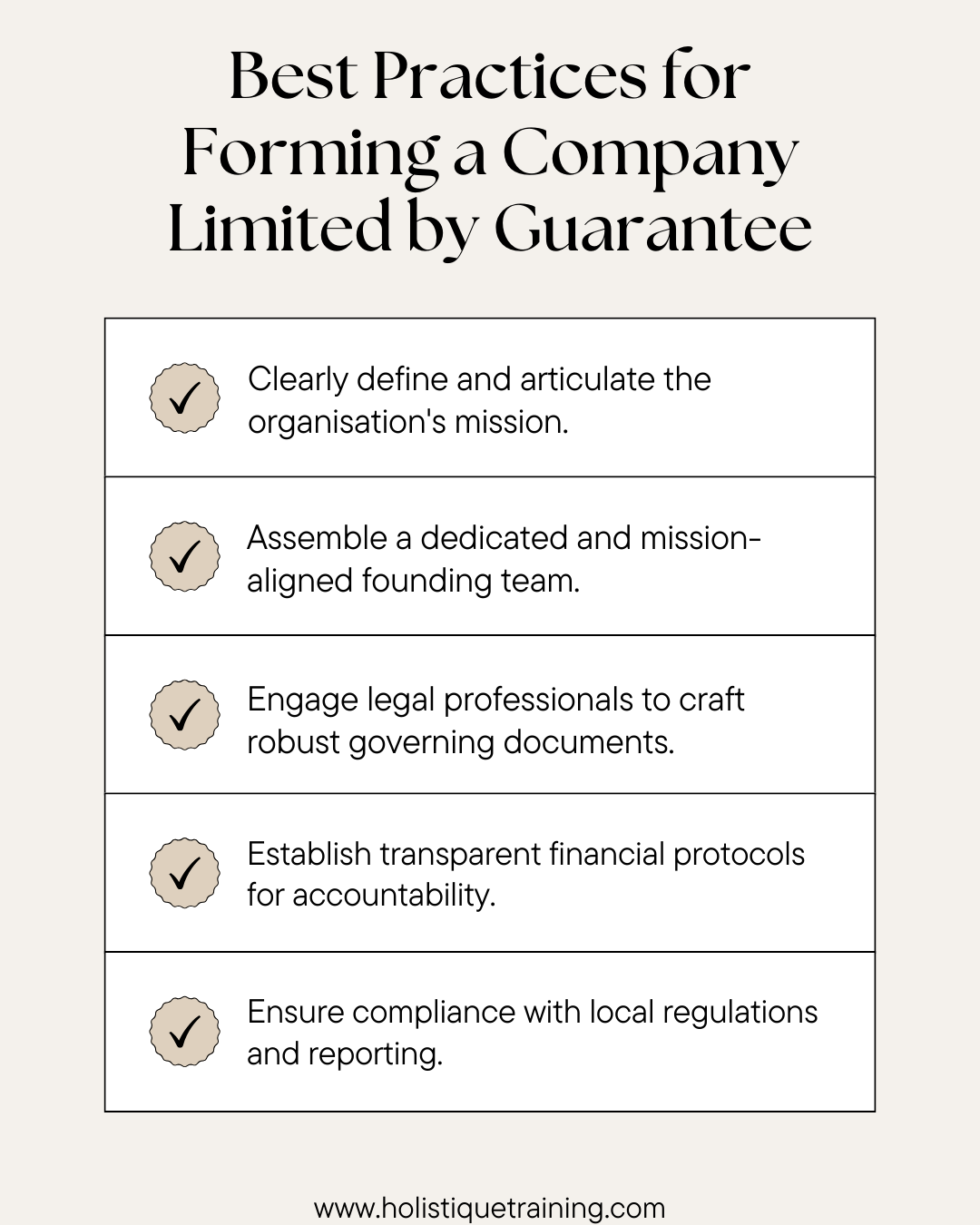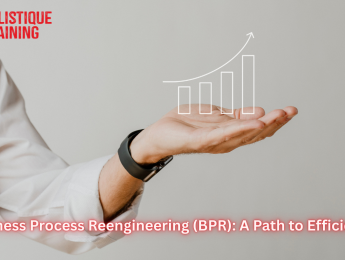- Table of Contents
- Introduction
- What Is a Company Limited by Guarantee?
- Can the Guarantors Take a Share of the Company’s Profits?
- The Main Goals of a Company Limited by Guarantee
- 1. Advancing a Charitable or Social Mission
- 2. Reinvesting Profits for Social Good
- 3. Sustaining Long-Term Impact
- 4. Building Community Trust and Credibility
- 5. Advocating for Social Change
- 6. Collaborating for Collective Impact
- 7. Fostering a Culture of Purpose and Passion
- What Is a Statement of Guarantee?
- Why Choose This Type of Company Formation?
- Tailored for Non-Profit Endeavours
- Access to Grants and Donations
- Stability Amid Market Volatility
- Credibility and Trustworthiness
- Reinvestment of Profits for Maximum Impact
- Flexibility in Ownership Structure
- Alignment with Social Responsibility Trends
- Exemption from Certain Taxes
- Requirements and Regulations You Should Be Aware of
- 1. Comprehensive Memorandum and Articles of Association
- 2. Clarity on Company Objectives
- 3. Appointment of Directors
- 4. Registration with Regulatory Bodies
- 5. Transparency and Reporting Obligations
- 6. Guarantor Commitments
- 7. Compliance with Charitable Status Requirements
- 8. Intellectual Property Considerations
- 9. Review of Local Regulations
- Forming a Company Limited by Guarantee: What You Need to Do
- 1. Assemble a Dedicated Team
- 2. Define the Mission and Objectives
- 3. Craft the Memorandum and Articles of Association
- 4. Register with the Relevant Authorities
- 5. Appoint Directors
- 6. Establish Operational Protocols
- 7. Seek Charitable Status (If Desired)
- 8. Develop a Strategic Plan
- 9. Establish Financial Protocols
- 10. Foster Stakeholder Engagement
- 11. Ongoing Compliance and Governance
- 12. Embrace a Culture of Learning and Adaptability
- How to Successfully Manage a Company Limited by Guarantee
- 1. Transparent Communication and Internal Collaboration
- 2. Strategic Planning and Regular Review
- 3. Engage with Stakeholders
- 4. Financial Prudence and Resource Allocation
- 5. Adaptability and Innovation
- 6. Continuous Learning and Development
- 7. Volunteer and Team Management
- 8. Impact Measurement and Reporting
- 9. Compliance with Legal and Regulatory Standards
- 10. Community Outreach and Advocacy
- 11. Technology Integration
- 12. Crisis Management and Resilience
- Conclusion
Introduction
Navigating the intricacies of company structures can be a daunting task, especially when the goal is not just profit, but a commitment to a cause. Companies Limited by Guarantee provide a unique framework for organisations driven by a purpose beyond financial gain. In this comprehensive guide, we'll delve into the key aspects of these entities, exploring their nature, ownership structure, goals, benefits, formation process, and effective management strategies.
What Is a Company Limited by Guarantee?
At its core, a Company Limited by Guarantee (CLG) is a legal structure designed for non-profit organisations, charities, and social enterprises. Unlike companies limited by shares, where shareholders hold ownership and are entitled to a share of profits, CLGs have no shareholders. Instead, they are owned by guarantors, individuals who commit to covering a nominal amount, often a token sum like one pound, in the event of the company winding up.
Can the Guarantors Take a Share of the Company’s Profits?
Contrary to companies with a shareholding structure, guarantors in a CLG do not participate in profit-sharing. The absence of dividends fosters a culture centred around the organisation's mission, ensuring that financial gains are reinvested to further the company's goals.
The Main Goals of a Company Limited by Guarantee
In the realm of business structures, the goals of a Company Limited by Guarantee (CLG) stand in stark contrast to the profit-centric objectives of traditional companies. Rooted in a commitment to social welfare, education, or other altruistic pursuits, CLGs are unique entities that prioritise purpose over pecuniary gain. Let's delve deeper into the overarching goals that drive these organisations and distinguish them from their profit-oriented counterparts.
1. Advancing a Charitable or Social Mission
At the heart of a CLG lies a fervent dedication to a cause that transcends financial interests. Whether it's promoting education, alleviating poverty, or addressing environmental concerns, CLGs exist to make a tangible and positive impact on society. The focus on a charitable or social mission is not just a peripheral aspect but permeates every decision and action taken by the organisation.
2. Reinvesting Profits for Social Good
In a CLG, the absence of shareholders redefines the purpose of accumulating profits. Instead of distributing dividends to stakeholders, the organisation reinvests its financial gains into advancing its mission. This unique approach ensures that every monetary success contributes directly to the betterment of the community or the cause the CLG serves.
3. Sustaining Long-Term Impact
CLGs are built for the long haul, designed to endure and continuously contribute to societal well-being. Unlike businesses with a profit imperative that may prioritise short-term gains, CLGs adopt a strategic outlook that emphasises sustained, meaningful impact over time. This commitment to longevity fosters stability and resilience, allowing CLGs to weather challenges and persist in their mission-driven endeavours.
4. Building Community Trust and Credibility
Trust is an invaluable currency for CLGs. Establishing and maintaining trust within the community and among stakeholders is paramount for these organisations. By consistently working toward their stated mission and transparently communicating their impact, CLGs cultivate credibility. This trust not only attracts support in the form of donations and volunteers but also solidifies the organisation's standing within the communities it serves.
5. Advocating for Social Change
CLGs often find themselves at the forefront of advocating for social change. Whether through educational initiatives, awareness campaigns, or direct interventions, these organisations leverage their resources and influence to address systemic issues and contribute to positive societal transformation. The advocacy component of CLGs underscores their commitment to not just ameliorate existing challenges but to address the root causes underlying them.
6. Collaborating for Collective Impact
Recognising the complexity of societal issues, CLGs actively seek collaboration with other organisations, government bodies, and community groups. This collaborative approach amplifies their impact by pooling resources, sharing expertise, and collectively addressing multifaceted challenges. The goal is to create a synergistic effect that goes beyond what individual organisations could achieve independently.
7. Fostering a Culture of Purpose and Passion
Within the internal workings of a CLG, there exists a unique culture—one driven by purpose and passion. Team members, volunteers, and directors are drawn to the organisation not just for employment or governance roles but because they resonate with the mission. This shared sense of purpose fosters a work environment where individuals are motivated by more than just a paycheck, resulting in a higher level of commitment and dedication.
In essence, the main goals of a Company Limited by Guarantee extend far beyond the financial ledger. These organisations represent a paradigm shift in the world of business, demonstrating that success is not solely measured in profits but in the positive, lasting impact made on the world. As CLGs navigate the intricate landscape of societal challenges, their goals remain steadfastly anchored in the pursuit of a better, more equitable, and compassionate world.
What Is a Statement of Guarantee?
Central to the formation of a CLG is the Statement of Guarantee. This document outlines the guarantors' commitment to cover the nominal amount in the event of dissolution. This crucial statement not only formalises the guarantors' roles but also sets the foundation for the organisation's altruistic journey.
Why Choose This Type of Company Formation?
Choosing the right company structure is a critical decision for any organisation, and for those with a strong commitment to social or charitable causes, a Company Limited by Guarantee (CLG) emerges as a compelling option. The benefits of opting for this distinct form of company formation extend beyond the conventional metrics of profit and dividends, offering a unique set of advantages that align with the altruistic objectives of the organisation.
Tailored for Non-Profit Endeavours
Perhaps the most apparent benefit of a CLG is its tailor-made structure for non-profit endeavours. Designed explicitly for organisations with a mission-driven focus, CLGs provide a legal framework that aligns with the pursuit of social, educational, or charitable goals. This specificity ensures that the organisational structure inherently supports and facilitates the intended purpose, fostering a seamless integration of mission and operation.
Access to Grants and Donations
The non-profit status of CLGs opens doors to a diverse range of funding sources, including grants and donations. Governments, foundations, and philanthropists often prefer to support organisations structured as CLGs due to the inherent assurance that profits are reinvested into the mission rather than distributed among shareholders. This access to a broader pool of financial support facilitates the sustained growth and impact of the organisation.
Stability Amid Market Volatility
Unlike companies with shareholders, CLGs are shielded from the fluctuations of the stock market. This inherent stability is particularly advantageous for organisations focused on long-term societal impact. It allows CLGs to navigate economic uncertainties without the pressure to generate immediate returns for investors, fostering a strategic approach that prioritises enduring impact over short-term financial gains.
Credibility and Trustworthiness
The decision to adopt a CLG structure often comes with an inherent boost in credibility. Stakeholders, including potential donors, volunteers, and collaborators, tend to view CLGs as organisations driven by purpose rather than profit. This perception of trustworthiness is a valuable asset that enhances the organisation's ability to attract support and establish enduring relationships within the community it serves.
Reinvestment of Profits for Maximum Impact
In a CLG, the absence of shareholders means that profits are not distributed as dividends. Instead, they are reinvested directly into the organisation's mission. This unique financial structure ensures that every monetary success translates into increased capacity to achieve the organisation's goals, amplifying the potential for positive societal impact.
Flexibility in Ownership Structure
The absence of shareholders also grants CLGs a unique flexibility in their ownership structure. Guarantors, who play a role akin to shareholders in other forms of companies, commit a nominal amount that is only called upon in the event of winding up. This structure allows for a diverse group of individuals to contribute to the organisation without the traditional expectations of financial returns.
Alignment with Social Responsibility Trends
As global consciousness shifts toward socially responsible business practices, CLGs find themselves at the forefront of a burgeoning trend. The focus on social impact, ethical conduct, and transparency inherent in CLGs aligns seamlessly with the expectations of a socially conscious audience. Choosing this type of company formation positions the organisation as a leader in the intersection of business and social responsibility.
Exemption from Certain Taxes
Depending on the jurisdiction, CLGs may enjoy tax exemptions or reduced tax rates, further optimising the allocation of resources toward the organisation's mission. Understanding and leveraging these tax benefits can significantly enhance the financial sustainability of the CLG, freeing up resources to be directed toward societal betterment.
In short, the decision to choose a Company Limited by Guarantee is more than a mere legal formality—it's a strategic alignment with values and a commitment to effecting positive change. The benefits inherent in this type of company formation empower organisations to transcend the traditional constraints of profit-driven models, paving the way for sustained impact and a legacy of meaningful contribution to society. As the landscape of business evolves, the appeal of CLGs continues to grow, marking them as catalysts for a new era of purpose-driven entrepreneurship
Requirements and Regulations You Should Be Aware of
Embarking on the journey of forming a Company Limited by Guarantee (CLG) requires a comprehensive understanding of the legal landscape and regulatory intricacies that govern these unique entities. From drafting foundational documents to complying with reporting obligations, careful navigation of the requirements and regulations is essential to establish a robust and legally sound framework for your organisation.
1. Comprehensive Memorandum and Articles of Association
The Memorandum and Articles of Association serve as the constitutional backbone of a CLG, defining its purpose, powers, and internal governance structure. Crafting these documents requires meticulous attention to detail. Clearly articulate the organisation's objectives, the role of guarantors, and the distribution of powers among directors. This foundational step sets the tone for the entire organisation and its alignment with legal standards.
2. Clarity on Company Objectives
Defining the objectives of the CLG is not just a matter of formality; it's a legal imperative. The objectives outlined in the Memorandum and Articles of Association should align precisely with the organisation's mission. This clarity not only establishes the organisation's legal standing but also ensures that its activities remain within the legal framework stipulated for non-profit entities.
3. Appointment of Directors
The selection and appointment of directors play a pivotal role in the effective governance of a CLG. Directors should be individuals who share the organisation's vision and can contribute meaningfully to its mission. Ensure compliance with any regulatory requirements related to the appointment and roles of directors, including any restrictions on remuneration or benefits they may receive.
4. Registration with Regulatory Bodies
Before operating as a CLG, it is imperative to register with the relevant regulatory bodies. In many jurisdictions, this involves submission of documents such as the Memorandum and Articles of Association, details of guarantors, and information about the organisation's registered office. Be mindful of deadlines and procedural requirements to avoid delays or legal complications during the registration process.
5. Transparency and Reporting Obligations
CLGs are often subject to heightened scrutiny due to their non-profit nature. Compliance with transparency and reporting obligations is paramount for maintaining public trust. Familiarise yourself with the specific reporting requirements in your jurisdiction, which may include financial statements, annual reports, and disclosures about the use of funds. Failure to meet these obligations can result in penalties and damage the organisation's reputation.
6. Guarantor Commitments
While guarantors in a CLG are not liable for the company's debts during its operation, they commit to covering a nominal amount in the event of winding up. Ensure that the obligations of guarantors are clearly stated in the Memorandum and Articles of Association. This transparency not only aligns with good governance practices but also fosters a clear understanding among guarantors regarding their financial responsibilities.
7. Compliance with Charitable Status Requirements
If the CLG seeks charitable status for tax exemptions or other benefits, it must comply with additional requirements imposed by charity regulators. This may include demonstrating that the organisation's activities are exclusively for charitable purposes, avoiding prohibited activities, and meeting specific criteria outlined by charity laws.
8. Intellectual Property Considerations
Safeguarding the intellectual property (IP) associated with the CLG's mission is crucial. Whether it involves trademarks, copyrights, or patents, understanding the legal nuances of IP protection ensures that the organisation's unique assets are shielded from unauthorised use, contributing to the long-term success of the CLG.
9. Review of Local Regulations
Regulations governing non-profit organisations can vary significantly from one jurisdiction to another. A thorough review of local laws and regulations ensures that the CLG remains compliant with regional legal requirements. This includes understanding any restrictions on fundraising activities, financial disclosures, and governance practices specific to the jurisdiction in which the CLG operates.
In short, navigating the requirements and regulations before forming a Company Limited by Guarantee is a foundational step that demands diligence and precision. By approaching the process with a keen awareness of legal obligations and a commitment to best practices in governance, an organisation can establish a solid framework that not only meets regulatory standards but also sets the stage for effective and impactful mission-driven endeavours.
Forming a Company Limited by Guarantee: What You Need to Do
The process of forming a Company Limited by Guarantee (CLG) is a pivotal undertaking that requires careful planning, attention to detail, and adherence to legal protocols. From conceptualisation to registration, each step contributes to the establishment of a robust foundation for the organisation's mission-driven endeavours. Here's a comprehensive guide on what you need to do when forming a CLG.
1. Assemble a Dedicated Team
The first building block in forming a CLG is assembling a team of like-minded individuals who share a commitment to the organisation's mission. This core group will play a crucial role in shaping the vision, drafting foundational documents, and navigating the intricacies of the formation process.
2. Define the Mission and Objectives
Clarity is paramount when defining the mission and objectives of the CLG. Engage in a collaborative process to articulate the organisation's purpose, specifying the societal or charitable goals it aims to achieve. This crystallisation of mission guides subsequent decisions and actions, ensuring alignment with the organisation's overarching vision.
3. Craft the Memorandum and Articles of Association
The Memorandum and Articles of Association serve as the organisational constitution, delineating the rules and structure of the CLG. Work closely with legal professionals to craft documents that not only comply with legal requirements but also encapsulate the ethos of the organisation. This includes detailing the company's objectives, the role of guarantors, and the internal governance structure.
4. Register with the Relevant Authorities
Initiate the formalisation of the CLG by registering with the appropriate regulatory bodies. Submit the requisite documents, including the Memorandum and Articles of Association, details of guarantors, and information about the registered office. Adhere strictly to deadlines and procedural requirements to expedite the registration process and ensure compliance with legal standards.

5. Appoint Directors
Selecting directors who align with the organisation's values and possess the skills necessary for effective governance is a pivotal step. The directors play a central role in decision-making and steering the CLG toward its mission. Ensure that the appointment process adheres to legal requirements and that the roles and responsibilities of directors are clearly defined.
6. Establish Operational Protocols
Develop operational protocols that guide the day-to-day functioning of the CLG. This includes financial management procedures, protocols for stakeholder engagement, and ethical guidelines that reflect the organisation's commitment to transparency and accountability. Establishing robust operational frameworks sets the stage for sustainable and impactful operations.
7. Seek Charitable Status (If Desired)
If the CLG aims to obtain charitable status for tax benefits or other advantages, familiarise yourself with the criteria and requirements outlined by charity regulators. Ensure that the organisation's activities align with the stipulated charitable purposes and comply with additional obligations imposed on charitable entities.
8. Develop a Strategic Plan
Crafting a strategic plan is not just a one-time exercise; it's an ongoing process that aligns organisational goals with a roadmap for achieving them. Engage stakeholders in the development of a comprehensive plan that outlines short-term and long-term objectives, potential challenges, and strategies for achieving the CLG's mission.
9. Establish Financial Protocols
Sound financial management is crucial for the sustainability of the CLG. Develop rigorous financial protocols, including budgeting, accounting, and reporting mechanisms. These protocols not only facilitate compliance with regulatory standards but also instil confidence among stakeholders in the prudent use of resources.
10. Foster Stakeholder Engagement
Cultivate meaningful relationships with stakeholders, including the community, donors, volunteers, and collaborators. Transparent communication and engagement efforts build trust and create a network of support essential for the CLG's success. Leverage various channels, such as social media and community events, to amplify the organisation's impact.
11. Ongoing Compliance and Governance
Post-formation, prioritise ongoing compliance with legal requirements and governance best practices. Regularly review and update documents such as the Memorandum and Articles of Association to ensure alignment with the organisation's evolving needs. Conduct periodic audits to assess compliance with reporting obligations and financial transparency standards.
12. Embrace a Culture of Learning and Adaptability
In the dynamic landscape of non-profit endeavours, adaptability is key to sustained success. Foster a culture of continuous learning within the organisation, encouraging team members to stay informed about industry trends, best practices, and emerging challenges. Embrace innovation and remain agile in responding to evolving societal needs.
By meticulously navigating each step in this strategic roadmap, organisations can lay the groundwork for a resilient and mission-driven Company Limited by Guarantee. Forming a CLG is not just a legal process—it's a transformative journey that, when approached with dedication and foresight, sets the stage for enduring positive impact and societal change.
How to Successfully Manage a Company Limited by Guarantee
The successful management of a Company Limited by Guarantee (CLG) goes beyond routine business practices; it involves weaving together mission-driven strategies, stakeholder engagement, and organisational resilience. Effectively steering a CLG requires a holistic approach that prioritises both the mission and the well-being of the organisation. Here's a comprehensive guide on how to successfully manage a CLG.
1. Transparent Communication and Internal Collaboration
Foster an organisational culture that thrives on transparent communication and collaboration. Establish clear channels for internal communication, ensuring that team members are well-informed about the organisation's goals, achievements, and challenges. This open dialogue creates a sense of shared purpose and strengthens the commitment of everyone involved.
2. Strategic Planning and Regular Review
Develop a robust strategic plan that outlines the CLG's objectives, milestones, and the roadmap for achieving its mission. Regularly review and update this plan to adapt to changing circumstances, emerging opportunities, and evolving societal needs. Strategic planning serves as a guiding framework, aligning the organisation's actions with its overarching goals.
3. Engage with Stakeholders
Stakeholder engagement is a cornerstone of successful CLG management. Build and nurture relationships with various stakeholders, including community members, donors, volunteers, and partner organisations. Engage stakeholders in decision-making processes, seeking their input and feedback. This collaborative approach not only strengthens community ties but also enhances the organisation's impact.
4. Financial Prudence and Resource Allocation
Sound financial management is critical for the sustainability of any organisation, including CLGs. Implement prudent financial practices, including budgeting, expense tracking, and regular financial reporting. Ensure that resources are allocated optimally to advance the CLG's mission while adhering to any legal and regulatory financial requirements.
5. Adaptability and Innovation
In the dynamic landscape of non-profit endeavours, adaptability is a key factor for success. Embraceinnovation and stay abreast of emerging trends and technologies that can enhance the organisation's efficiency and impact. A willingness to adapt to changing circumstances ensures that the CLG remains relevant and resilient in the face of evolving challenges.
6. Continuous Learning and Development
Foster a culture of continuous learning and development within the organisation. Encourage team members to pursue professional development opportunities, stay informed about industry best practices, and engage in ongoing education related to the CLG's mission. This commitment to learning enhances the expertise and effectiveness of the team.
7. Volunteer and Team Management
Effectively manage and support volunteers and staff who contribute to the CLG's mission. Provide clear roles and responsibilities, offer opportunities for skill development, and recognise and appreciate their contributions. A motivated and well-managed team is essential for the sustained success of the organisation.
8. Impact Measurement and Reporting
Establish mechanisms for measuring and reporting the impact of the CLG's activities. Clearly articulatekey performance indicators (KPIs) and regularly assess progress toward achieving them. Transparently communicate impact to stakeholders through reports, presentations, and other channels, demonstrating accountability and building trust.
Table 1: Examples of Key Performance Indicators
Key Performance Indicator (KPI) | Description | Measurement Approach |
Community Outreach Impact | Gauge the reach and impact of outreach programs | Number of beneficiaries reached |
Fundraising Effectiveness | Assess the success of fundraising initiatives | Percentage increase in donations |
Stakeholder Engagement Satisfaction | Measure satisfaction levels among stakeholders | Survey responses and feedback |
Mission Alignment of Programs | Evaluate how well programs align with the mission | Percentage of programs aligned |
Financial Sustainability | Assess the organisation's long-term financial health | Ratio of income to operating expenses |
9. Compliance with Legal and Regulatory Standards
Maintain rigorous compliance with legal and regulatory standards relevant to CLGs. Stay informed about any changes in legislation that may affect the organisation. Regularly review and update governing documents, ensuring alignment with current legal requirements. Compliance builds credibility and safeguards the organisation's reputation.
10. Community Outreach and Advocacy
Extend the reach of the CLG's mission through community outreach and advocacy. Actively participate in community events, collaborate with local organisations, and leverage various communication channels to amplify the organisation's voice. Advocate for positive societal change aligned with the CLG's mission.
11. Technology Integration
Leverage technology to streamline processes, enhance communication, and optimise organisational efficiency. Explore tools and platforms that can assist with fundraising, volunteer management, and data analysis. Technology integration not only improves internal operations but also expands the CLG's reach and impact.
12. Crisis Management and Resilience
Develop a robust crisis management plan to navigate unexpected challenges. This plan should outline procedures for communication, resource allocation, and decision-making during times of crisis. Building organisational resilience ensures that the CLG can weather challenges and continue its mission despite unforeseen circumstances.
In summary, the successful management of a Company Limited by Guarantee requires a multifaceted approach that blends strategic vision, stakeholder engagement, financial acumen, and adaptability. By embracing these strategies, CLGs can not only achieve their mission but also foster a culture of impact, innovation, and sustainability. Managing a CLG is a dynamic journey that, when approached with dedication and strategic foresight, paves the way for enduring positive change in society.
Conclusion
In conclusion, Companies Limited by Guarantee offer a unique avenue for organisations to pursue their missions without the constraints of profit-driven structures. By understanding the intricacies of CLGs, adhering to regulatory requirements, and implementing effective management strategies, these entities can thrive and make a lasting positive impact on society. As we navigate the dynamic landscape of business and social responsibility, the distinctive qualities of CLGs position them as a compelling choice for those committed to driving meaningful change.


















